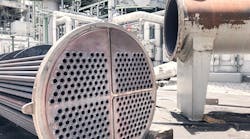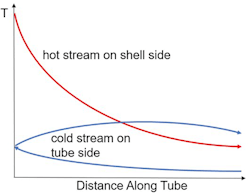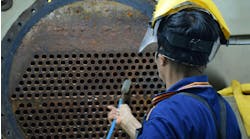The heat exchanger system can have a huge impact on the overall energy efficiency of an industrial process (see, “Take the Heat Off Pinch Analysis,” from July 2019, and “Design in a Pinch,” November 2021). Most heat exchangers handle one “hot stream” at a relatively high temperature and one “cold stream” at a lower temperature; the temperature of the hot stream falls, while that of the cold stream rises. Simple, right? Not always.
Shell-and-tube heat exchangers (STHEs), the main workhorses in the process industries, consist of shells (pressure vessels) with bundles of tubes inside. Relatively cheap and robust, STHEs can be fabricated from a variety of materials and are typically easy to clean and maintain. They also can be designed for a wide range of sizes, operating temperatures and pressures.
An STHE has two flow paths — the “tube side” (i.e., inside the tubes), and the “shell side” (i.e., inside the shell, but outside the tubes). Depending on various factors, such as flow rates, viscosities, and propensity to fouling, we can choose to route the cold stream through the shell side and the hot stream through the tube side, or vice versa. (For more on which fluid should go on which side, see: “Pick the Right Side.") Below we assume the hot stream is on shell side.
Heat transfer is most efficient with countercurrent flow, and a uniform temperature difference between the hot and cold streams. In most STHEs, the shell-side flow path has just one pass — in at one end, and out at the other. (Most shells contain baffles perpendicular to the tubes, so the shell-side path also includes a cross-flow component.) However, the tube-side flow path is usually multi-pass — from one end of the STHE to the other and back again, often several times. The tube-side flow therefore alternates between countercurrent and co-current relative to the shell-side flow. This can lead to “temperature cross,” where the outlet temperature of the hot stream is lower than the outlet temperature of the cold stream. When this happens, the tube-side fluid heats up when flowing in the countercurrent direction, but cools down in part of the co-current pass (see Figure 1). This limits the achievable temperature approach; adding heat transfer area does little to increase heat recovery.
Figure 1. Tube-side fluid heats up when flowing in the countercurrent direction, but cools down in part of the co-current pass.
We can achieve a closer temperature approach by combining several STHEs in series. The temperatures of both the hot and cold streams now change only a relatively small amount within each STHE, thus avoiding temperature cross. However, adding STHEs is more expensive than simply increasing the heat transfer area in a single STHE. The extra cost can be significant, especially where close temperature approaches are needed, either because of process constraints or to maximize heat recovery.
Other options are sometimes possible. For examples, “F-shell” STHEs have two shell-side passes. If there are also two tube-side passes, this yields pure countercurrent flow. Plate heat exchangers and spiral heat exchangers, and some other types, also offer countercurrent flow; in certain cases, they are a cost-effective option for achieving close temperature approaches.
Additional information:
Alan Rossiter & Beth Jones, “Energy Management and Efficiency for the Process Industries,” AIChE/John Wiley & Sons, Inc., Hoboken, New Jersey, 2015, Chapter 10, Enhanced Heat Transfer and Energy Efficiency, by Thomas Lestina.




